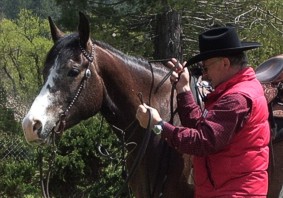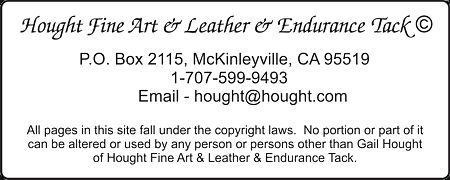|
Art Gallery (Horse Art) |
|
|
|
|
|
||||||
|
6/12/04 The two examples described should plant the seed how to apply slow hands to the stop. Loping or cantering along, apply slow hands until he hears the suggestion and he drops down into the trot, release. He should stay in the trot, if he doesn't maintain the trot, get into it as gently as possible. Stay in the trot until you suggest with slow hands and he hears you. He should drop into the walk, release. Allow him to walk along and slowly increase the volume of slow hands until he stops, release. The reward for finding the correct answer is always the release. Situation number two also begins from the lope. Increase the volume, as before, with slow hands until he drops down into the trot, release. Trot along, slowly increase the volume of slow hands until he hears you and drops down into the walk, release. Walk along, slowly increase the volume of slow hands and he stops, do not release, hold. What would he think? Yes, continue to increase the volume, eventually, he will find the correct answer and back until you release. Early in the learning, 3-4 steps are enough. As he increases his skill, more steps can be asked and backing straight can be required. The use of your legs in the single rein stop by disengaging the hindquarters will cause him to become sensitive to your leg pressure. The body position of the rider should be as still as possible. That is so because it will not confuse him with multiple cues. Your body language must be very clear especially in the early stages of preparing the young horse. Remember to ride though the signal. Don't push with your feet or sit down in the seat. If you have been consistent with slow hands, you should be able to use one hand to ask him to stop. I suspect you have been posting or holding the horn so, grasp the horn and hold the somewhat standing position, out of the seat, and ride though the stop. That way you don't send multiple signals, only the slow hands. Are you beginning to get the feel? The converse of the release is the cluck. He should continue to increase speed as long as he continues to hear the cluck. From the walk if he trots and I am looking for the lope, he will continue to hear the cluck until he lopes etc. What do you do if he isn't responding to the cluck? Simple, increase the volume with your leg, spur or judiciously spank him with the end of the rein. Assume I am walking along and I cluck once. He should increase in speed. If he doesn't increase speed, I continue clucking until he trots. When he trots I stop the cluck and I only continue to use it if he drops down into the walk. Remember he will become sound sensitive if he only hears the cluck and the word whoa. I didn't use the word, whoa, in the above, because I want him to be sound sensitive. Eventually I will begin to use it as accent when I want him to stop quickly. Yes, clear communication of black or white with no gray, is important and will not require him to use reasoning to hope he found the correct answer. I check myself all the time to determine if I am using the clearest cue. We too can get into habits that slowly slip into our riding without being conscience of it. |
||||||
|

